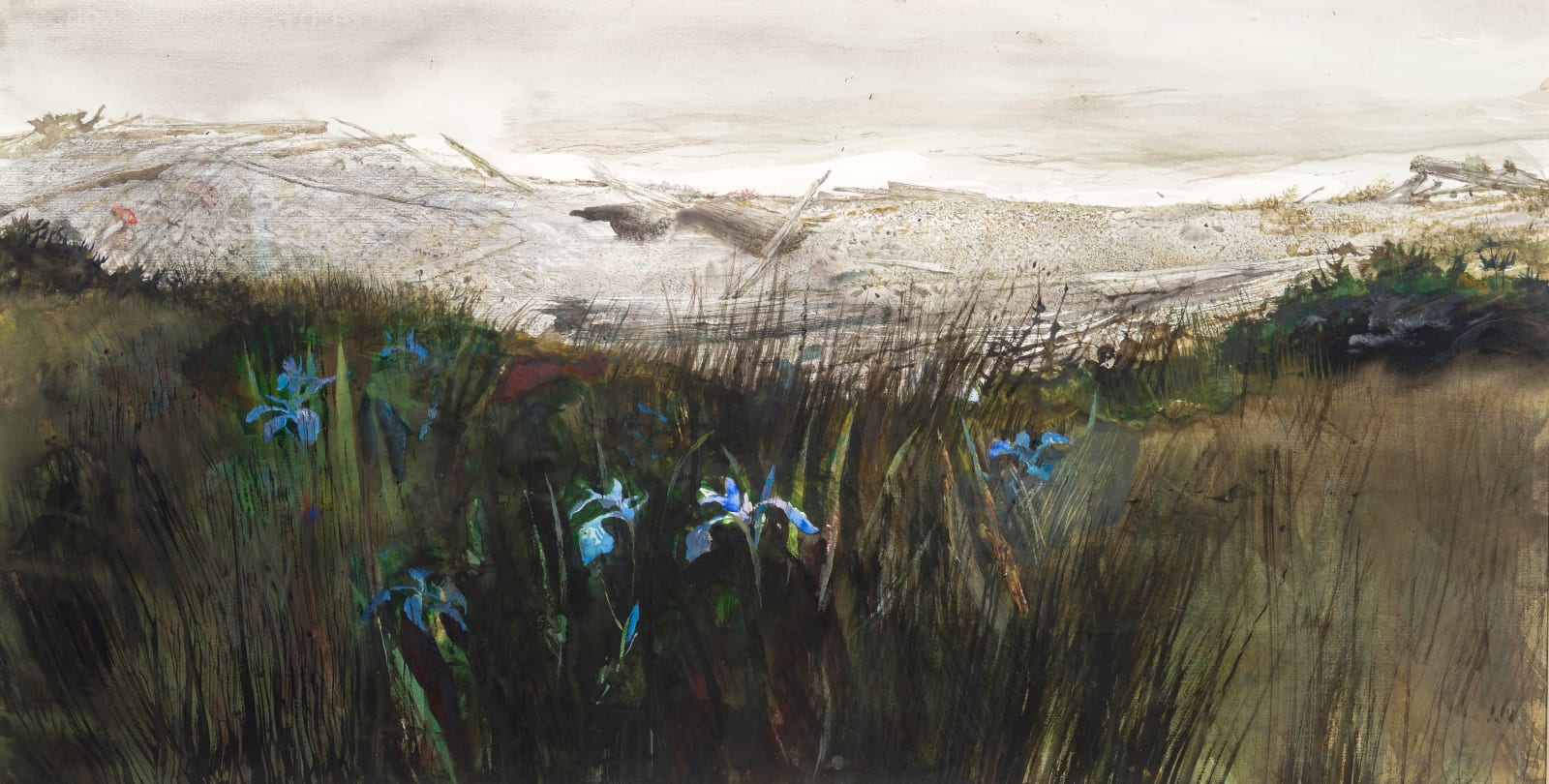 © 2025 Wyeth Foundation for American Art / Artists Rights Society (ARS), New York
ANDREW WYETH
© 2025 Wyeth Foundation for American Art / Artists Rights Society (ARS), New York
ANDREW WYETHFlags at Sea
© 2025 Wyeth Foundation for American Art / Artists Rights Society (ARS), New York
 © 2025 Wyeth Foundation for American Art / Artists Rights Society (ARS), New York
ANDREW WYETH
© 2025 Wyeth Foundation for American Art / Artists Rights Society (ARS), New York
ANDREW WYETHFlags at Sea
© 2025 Wyeth Foundation for American Art / Artists Rights Society (ARS), New York
Andrew Wyeth 1917-2009
Framed dimensions: 29 1/2 x 48 1/4 inches
Andrew Wyeth’s Flags at Sea depicts a cluster of electric-blue flag irises overlooking a misty Maine beach. However, the brilliant, almost phosphorescent blooms in the foreground are such a stunning blue that, amidst their field of dark green grass, they seem like otherworldly sprites, will o’ the wisps waiting to lead the viewer into the ghostly white-grey fog. Patricia Junker observes that in Wyeth’s later works, he “seems to have tried to infuse a greater sense of ‘magic’ into his ‘realism’” (Junker, “Reflection, 1989-2009,” in Andrew Wyeth: In Retrospect, 186). Flags at Sea, painted in 1997, undoubtedly belongs within this category of later, pointedly mystical paintings. At the same time, Flags is inextricably tied to Wyeth’s long lineage of Maine watercolors and that of his complex visual language, in which nothing is straightforward–– “what I’m trying to get across,” said Wyeth, “is what makes things sublime, the difference between profound art and art that’s just objects” (Andrew Wyeth, for Andrew Wyeth: A Spoken Self-Portrait, 45).
In Flags at Sea, Wyeth entirely achieved his sought-after sense of the sublime. It is particularly powerful in the dunes beyond the grass and in the foreboding sky; sharing in their deathly paleness, they seem unimaginably vast. Also, though there is a wild grandeur to the whole painting, the characterization of the unforgiving Maine landscape is especially striking in the background. The sublimity of the dunes and sky is due in part to their near abstraction. Just as the flags seem like glowing spirits at first glance, the sand and the sky, formed by Wyeth in great, misty swaths of paint, are not initially recognizable, instead appearing as ghosts or a dream-like fog. In his essay Islands, Christopher B. Crosman writes that “islands envisioned by Wyeth beckon and summon…veering, swooping spirits ‘on their vast strange errands’” (Crosman, “Islands” in Andrew Wyeth: In Retrospect, 86). Here, the concept of islands extends to the New England coast, made magical by Wyeth’s imagination, sublime in its own right.
Wyeth has long painted a magical version of Maine. His early watercolors, coincidentally his first commercial successes, depicted Maine: its waters and skies, the people and animals that called it home. Now referred to as his “blue-sky” period for the paintings’ vibrant, bold, colors, these watercolors are markedly different from Wyeth’s mature watercolors and temperas, with their rich, muted palettes and distinctive dryness. While very different than Flags at Sea, these blue-sky paintings, such as The Lobsterman (1937) treat the Maine landscape with the same awe and recognize the same qualities of otherworldliness in the coastal terrain. Flags, therefore, contains a sort of memory trace of the blue-sky period, which contributes to the reflective depth of the scene.
The nominal irises, rife with double meanings, extend the depth of Flags at Sea. The very title of the painting is a riddle of sorts, referring literally to the flag variety of the iris, but also to the system of flags that are used to signal water conditions and potential hazards at sea. Andrew Wyeth famously filled his paintings “with hidden symbolism and self-exploration,” turning each painting into a “deliberate [puzzle]” that “[challenges] the viewer to decode them” (Anne Classen Knutson, “Andrew Wyeth’s Language of Things,” in Andrew Wyeth: Memory & Magic, 47). Flags at Sea is no exception, going beyond the puzzle in its name to the puzzle of the flowers, or flags, themselves. Organic matter, functioning as a “metaphor for the fragility of life,” seems here to reflect the thoughts and emotions of an aging artist, and more simply, an aging man (Knutson, 47). Wyeth was 80 years old when Flags was completed and behind him was a remarkably full life, both artistically and personally. With this in mind, Flags becomes a reflective picture, musing on what the future may hold for Wyeth. The irises, like guiding will o’ the wisp spirits, exist to guide Wyeth himself, and the blankness of the sand dunes and sky acts as a symbol for an unknown future.
“When you really begin to peer into something, a simple object, and realize that profound meaning of that thing…there’s no end.” This quote from Andrew Wyeth, although not specifically referring to Flags at Sea, nonetheless perfectly encapsulates the endless depth and meaning afforded by the painting, with all its sublime mysticality (Wyeth in The Art of Andrew Wyeth, 45). Wyeth is known best for his unflinching realism, but it is his hints of surreality, the way he “[infuses]” magic into his works, that makes his paintings so captivating. In Flags, we are truly transported into Wyeth’s world, a reflective and magical Maine that “[exerts] its strange hold, pulling us into places ‘where the past is vastly alive, and the future is not separated off.’” (Crosman, 86).
Provenance
The artist;
Private collection, until 2025
Literature
Historic Beaufort Foundation. Beaufort, Beaufort, SC, 2003
Please join our mailing list
* denotes required fields
We will process the personal data you have supplied in accordance with our privacy policy (available on request). You can unsubscribe or change your preferences at any time by clicking the link in our emails.

